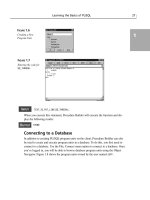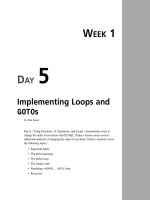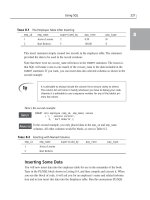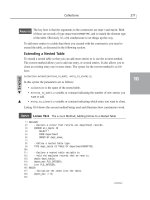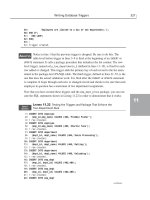Tài liệu Teach Yourself Perl 5 in 21 days doc
Bạn đang xem bản rút gọn của tài liệu. Xem và tải ngay bản đầy đủ của tài liệu tại đây (2.98 MB, 1,124 trang )
Teach Yourself Perl 5 in 21 days
David Till
Table of Contents:
Introduction
● Who Should Read This Book?
● Special Features of This Book
● Programming Examples
● End-of-Day Q& A and Workshop
● Conventions Used in This Book
● What You'll Learn in 21 Days
Week 1 Week at a Glance
● Where You're Going
Day 1 Getting Started
● What Is Perl?
● How Do I Find Perl?
❍ Where Do I Get Perl?
❍ Other Places to Get Perl
● A Sample Perl Program
● Running a Perl Program
❍ If Something Goes Wrong
● The First Line of Your Perl Program: How Comments Work
❍ Comments
● Line 2: Statements, Tokens, and <STDIN>
❍ Statements and Tokens
❍ Tokens and White Space
❍ What the Tokens Do: Reading from Standard Input
● Line 3: Writing to Standard Output
❍ Function Invocations and Arguments
● Error Messages
● Interpretive Languages Versus Compiled Languages
● Summary
● Q&A
● Workshop
❍ Quiz
❍ Exercises
Day 2 Basic Operators and Control Flow
● Storing in Scalar Variables Assignment
❍ The Definition of a Scalar Variable
❍ Scalar Variable Syntax
❍ Assigning a Value to a Scalar Variable
● Performing Arithmetic
❍ Example of Miles-to-Kilometers Conversion
❍ The chop Library Function
● Expressions
❍ Assignments and Expressions
● Other Perl Operators
● Introduction to Conditional Statements
● The if Statement
❍ The Conditional Expression
❍ The Statement Block
❍ Testing for Equality Using ==
❍ Other Comparison Operators
● Two-Way Branching Using if and else
● Multi-Way Branching Using elsif
● Writing Loops Using the while Statement
● Nesting Conditional Statements
● Looping Using the until Statement
● Summary
● Q&A
● Workshop
❍ Quiz
❍ Exercises
Day 3 Understanding Scalar Values
● What Is a Scalar Value?
● Integer Scalar Values
❍ Integer Scalar Value Limitations
● Floating-Point Scalar Values
❍ Floating-Point Arithmetic and Round-Off Error
● Using Octal and Hexadecimal Notation
❍ Decimal Notation
❍ Octal Notation
❍ Hexadecimal Notation
❍ Why Bother?
● Character Strings
❍ Using Double-Quoted Strings
❍ Escape Sequences
❍ Single-Quoted Strings
● Interchangeability of Strings and Numeric Values
❍ Initial Values of Scalar Variables
● Summary
● Q&A
● Workshop
❍ Quiz
❍ Exercises
Day 4 More Operators
● Using the Arithmetic Operators
❍ Exponentiation
❍ The Remainder Operator
❍ Unary Negation
● Using Comparison Operators
❍ Integer-Comparison Operators
❍ String-Comparison Operators
❍ String Comparison Versus Integer Comparison
❍ Comparison and Floating-Point Numbers
● Using Logical Operators
❍ Evaluation Within Logical Operators
❍ Logical Operators as Subexpressions
● Using Bit-Manipulation Operators
❍ What Bits Are and How They Are Used
❍ The Bit-Manipulation Operators
● Using the Assignment Operators
❍ Assignment Operators as Subexpressions
● Using Autoincrement and Autodecrement
❍ The Autoincrement Operator Pre-Increment
❍ The Autoincrement Operator Post-Increment
❍ The Autodecrement Operator
❍ Using Autoincrement With Strings
● The String Concatenation and Repetition Operators
❍ The String-Concatenation Operator
❍ The String-Repetition Operator
❍ Concatenation and Assignment
● Other Perl Operators
❍ The Comma Operator
❍ The Conditional Operator
● The Order of Operations
❍ Precedence
❍ Associativity
❍ Forcing Precedence Using Parentheses
● Summary
● Q&A
● Workshop
❍ Quiz
❍ Exercises
Day 5 Lists and Array Variables
● Introducing Lists
● Scalar Variables and Lists
❍ Lists and String Substitution
● Storing Lists in Array Variables
● Accessing an Element of an Array Variable
❍ More Details on Array Element Names
● Using Lists and Arrays in Perl Programs
❍ Using Brackets and Substituting for Variables
● Using List Ranges
❍ Expressions and List Ranges
● More on Assignment and Array Variables
❍ Copying from One Array Variable to Another
❍ Using Array Variables in Lists
❍ Substituting for Array Variables in Strings
❍ Assigning to Scalar Variables from Array Variables
● Retrieving the Length of a List
● Using Array Slices
❍ Using List Ranges in Array-Slice Subscripts
❍ Using Variables in Array-Slice Subscripts
❍ Assigning to Array Slices
❍ Overlapping Array Slices
❍ Using the Array-Slice Notation as a Shorthand
● Reading an Array from the Standard Input File
● Array Library Functions
❍ Sorting a List or Array Variable
❍ Reversing a List or Array Variable
❍ Using chop on Array Variables
❍ Creating a Single String from a List
❍ Splitting a String into a List
❍ Other List-Manipulation Functions
● Summary
● Q&A
● Workshop
❍ Quiz
❍ Exercises
Day 6 Reading from and Writing to Files
● Opening a File
❍ The File Variable
❍ The Filename
❍ The File Mode
❍ Checking Whether the Open Succeeded
● Reading from a File
❍ File Variables and the Standard Input File
❍ Terminating a Program Using die
❍ Reading into Array Variables
● Writing to a File
❍ The Standard Output File Variable
❍ Merging Two Files into One
● Redirecting Standard Input and Standard Output
● The Standard Error File
● Closing a File
● Determining the Status of a File
❍ File-Test Operator Syntax
❍ Available File-Test Operators
❍ More on the -e Operator
❍ Testing for Read Permission-the -r Operator
❍ Checking for Other Permissions
❍ Checking for Empty Files
❍ Using File-Test Operators with File Variables
● Reading from a Sequence of Files
❍ Reading into an Array Variable
● Using Command-Line Arguments as Values
❍ ARGV and the <> Operator
● Opening Pipes
● Summary
● Q&A
● Workshop
❍ Quiz
❍ Exercises
Day 7 Pattern Matching
● Introduction
● The Match Operators
❍ Match-Operator Precedence
● Special Characters in Patterns
❍ The + Character
❍ The [] Special Characters
❍ The * and ? Special Characters
❍ Escape Sequences for Special Characters
❍ Matching Any Letter or Number
❍ Anchoring Patterns
❍ Variable Substitution in Patterns
❍ Excluding Alternatives
❍ Character-Range Escape Sequences
❍ Matching Any Character
❍ Matching a Specified Number of Occurrences
❍ Specifying Choices
❍ Reusing Portions of Patterns
❍ Pattern-Sequence Scalar Variables
❍ Special-Character Precedence
❍ Specifying a Different Pattern Delimiter
● Pattern-Matching Options
❍ Matching All Possible Patterns
❍ Ignoring Case
❍ Treating the String as Multiple Lines
❍ Evaluating a Pattern Only Once
❍ Treating the String as a Single Line
❍ Using White Space in Patterns
● The Substitution Operator
❍ Using Pattern-Sequence Variables in Substitutions
❍ Options for the Substitution Operator
❍ Evaluating a Pattern Only Once
❍ Treating the String as Single or Multiple Lines
❍ Using White Space in Patterns
❍ Specifying a Different Delimiter
● The Translation Operator
❍ Options for the Translation Operator
● Extended Pattern-Matching
❍ Parenthesizing Without Saving in Memory
❍ Embedding Pattern Options
❍ Positive and Negative Look-Ahead
❍ Pattern Comments
● Summary
● Q&A
● Workshop
❍ Quiz
❍ Exercises
Week 1 Week 1 in Review
Week 2
Week 2 at a Glance
● Where You're Going
Day 8 More Control Structures
● Using Single-Line Conditional Statements
❍ Problems with Single-Line Conditional Statements
● Looping Using the for Statement
❍ Using the Comma Operator in a for Statement
● Looping Through a List: The foreach Statement
❍ The foreach Local Variable
❍ Changing the Value of the Local Variable
❍ Using Returned Lists in the foreach Statement
● The do Statement
● Exiting a Loop Using the last Statement
● Using next to Start the Next Iteration of a Loop
● The redo Statement
● Using Labeled Blocks for Multilevel Jumps
❍ Using next and redo with Labels
● The continue Block
● The goto Statement
● Summary
● Q&A
● Workshop
❍ Quiz
❍ Exercises
Day 9 Using Subroutines
● What Is a Subroutine?
● Defining and Invoking a Subroutine
❍ Forward References to Subroutines
● Returning a Value from a Subroutine
❍ Return Values and Conditional Expressions
● The return Statement
● Using Local Variables in Subroutines
❍ Initializing Local Variables
● Passing Values to a Subroutine
❍ Passing a List to a Subroutine
● Calling Subroutines from Other Subroutines
● Recursive Subroutines
● Passing Arrays by Name Using Aliases
● Using the do Statement with Subroutines
● Specifying the Sort Order
● Predefined Subroutines
❍ Creating Startup Code Using BEGIN
❍ Creating Termination Code Using END
❍ Handling Non-Existent Subroutines Using AUTOLOAD
● Summary
● Q&A
● Workshop
❍ Quiz
❍ Exercises
Day 10 Associative Arrays
● Limitations of Array Variables
● Definition
● Referring to Associative Array Elements
● Adding Elements to an Associative Array
● Creating Associative Arrays
● Copying Associative Arrays from Array Variables
● Adding and Deleting Array Elements
● Listing Array Indexes and Values
● Looping Using an Associative Array
● Creating Data Structures Using Associative Arrays
❍ Linked Lists
❍ Structures
❍ Trees
❍ Databases
❍ Example: A Calculator Program
● Summary
● Q&A
● Workshop
❍ Quiz
❍ Exercises
Day 11 Formatting Your Output
● Defining a Print Format
● Displaying a Print Format
● Displaying Values in a Print Format
❍ Creating a General-Purpose Print Format
❍ Choosing a Value-Field Format
❍ Printing Value-Field Characters
❍ Using the Multiline Field Format
● Writing to Other Output Files
❍ Saving the Default File Variable
● Specifying a Page Header
❍ Changing the Header Print Format
● Setting the Page Length
❍ Using print with Pagination
● Formatting Long Character Strings
❍ Eliminating Blank Lines When Formatting
❍ Supplying an Indefinite Number of Lines
● Formatting Output Using printf
● Summary
● Q&A
● Workshop
❍ Quiz
❍ Exercises
Day 12 Working with the File System
● File Input and Output Functions
❍ Basic Input and Output Functions
❍ Skipping and Rereading Data
❍ System Read and Write Functions
❍ Reading Characters Using getc
❍ Reading a Binary File Using binmode
● Directory-Manipulation Functions
❍ The mkdir Function
❍ The chdir Function
❍ The opendir Function
❍ The closedir Function
❍ The readdir Function
❍ The telldir and seekdir Functions
❍ The rewinddir Function
❍ The rmdir Function
● File-Attribute Functions
❍ File-Relocation Functions
❍ Link and Symbolic Link Functions
❍ File-Permission Functions
❍ Miscellaneous Attribute Functions
● Using DBM Files
❍ The dbmopen Function
❍ The dbmclose Function
● Summary
● Q&A
● Workshop
❍ Quiz
❍ Exercises
Day 13 Process, String, and Mathematical Functions
● Process- and Program-Manipulation Functions
❍ Starting a Process
❍ Terminating a Program or Process
❍ Execution Control Functions
❍ Miscellaneous Control Functions
● Mathematical Functions
❍ The sin and cos Functions
❍ The atan2 Function
❍ The sqrt Function
❍ The exp Function
❍ The log Function
❍ The abs Function
❍ The rand and srand Functions
● String-Manipulation Functions
❍ The index Function
❍ The rindex Function
❍ The length Function
❍ Retrieving String Length Using tr
❍ The pos Function
❍ The substr Function
❍ The study Function
❍ Case Conversion Functions
❍ The quotemeta Function
❍ The join Function
❍ The sprintf Function
● Summary
● Q&A
● Workshop
❍ Quiz
❍ Exercises
Day 14 Scalar-Conversion and List-Manipulation Functions
● The chop Function
● The chomp Function
● The crypt Function
● The hex Function
● The int Function
● The oct Function
❍ The oct Function and Hexadecimal Integers
● The ord and chr Functions
● The scalar Function
● The pack Function
❍ The pack Function and C Data Types
● The unpack Function
❍ Unpacking Strings
❍ Skipping Characters When Unpacking
❍ The unpack Function and uuencode
● The vec Function
● The defined Function
● The undef Function
● Array and List Functions
❍ The grep Function
❍ The splice Function
❍ The shift Function
❍ The unshift Function
❍ The push Function
❍ The pop Function
❍ Creating Stacks and Queues
❍ The split Function
❍ The sort and reverse Functions
❍ The map Function
❍ The wantarray Function
● Associative Array Functions
❍ The keys Function
❍ The values Function
❍ The each Function
❍ The delete Function
❍ The exists Function
● Summary
● Q&A
● Workshop
❍ Quiz
❍ Exercises
Week 2 Week 2 in Review
Week 3
Week 3 at a Glance
● Where You're Going
Day 15 System Functions
● System Library Emulation Functions
❍ The getgrent Function
❍ The setgrent and endgrent Functions
❍ The getgrnam Function
❍ The getgrid Function
❍ The getnetent Function
❍ The getnetbyaddr Function
❍ The getnetbyname Function
❍ The setnetent and endnetent Functions
❍ The gethostbyaddr Function
❍ The gethostbyname Function
❍ The gethostent, sethostent, and endhostent Functions
❍ The getlogin Function
❍ The getpgrp and setpgrp Functions
❍ The getppid Function
❍ The getpwnam Function
❍ The getpwuid Function
❍ The getpwent Function
❍ The setpwent and endpwent Functions
❍ The getpriority and setpriority Functions
❍ The getprotoent Function
❍ The getprotobyname and getprotobynumber Functions
❍ The setprotoent and endprotoent Functions
❍ The getservent Function
❍ The getservbyname and getservbyport Functions
❍ The setservent and endservent Functions
❍ The chroot Function
❍ The ioctl Function
❍ The alarm Function
❍ Calling the System select Function
❍ The dump Function
● Socket-Manipulation Functions
❍ The socket Function
❍ The bind Function
❍ The listen Function
❍ The accept Function
❍ The connect Function
❍ The shutdown Function
❍ The socketpair Function
❍ The getsockopt and setsockopt Functions
❍ The getsockname and getpeername Functions
● The UNIX System V IPC Functions
❍ IPC Functions and the require Statement
❍ The msgget Function
❍ The msgsnd Function
❍ The msgrcv Function
❍ The msgctl Function
❍ The shmget Function
❍ The shmwrite Function
❍ The shmread Function
❍ The shmctl Function
❍ The semget Function
❍ The semop Function
❍ The semctl Function
● Summary
● Q&A
● Workshop
❍ Quiz
❍ Exercises
Day 16 Command-Line Options
● Specifying Options
❍ Specifying Options on the Command Line
❍ Specifying an Option in the Program
● The -v Option: Printing the Perl Version Number
● The -c Option: Checking Your Syntax
● The -w Option: Printing Warnings
❍ Checking for Possible Typos
❍ Checking for Redefined Subroutines
❍ Checking for Incorrect Comparison Operators
● The -e Option: Executing a Single-Line Program
● The -s Option: Supplying Your Own Command-Line Options
❍ The -s Option and Other Command-Line Arguments
● The -P Option: Using the C Preprocessor
❍ The C Preprocessor: A Quick Overview
● The -I Option: Searching for C Include Files
● The -n Option: Operating on Multiple Files
● The -p Option: Operating on Files and Printing
● The -i Option: Editing Files
❍ Backing Up Input Files Using the -i Option
● The -a Option: Splitting Lines
● The -F Option: Specifying the Split Pattern
● The -0 Option: Specifying Input End-of-Line
● The -l Option: Specifying Output End-of-Line
● The -x Option: Extracting a Program from a Message
● Miscellaneous Options
❍ The -u Option
❍ The -U Option
❍ The -S Option
❍ The -D Option
❍ The -T Option: Writing Secure Programs
● The -d Option: Using the Perl Debugger
● Summary
● Q&A
● Workshop
❍ Quiz
❍ Exercises
Day 17 System Variables
● Global Scalar Variables
❍ The Default Scalar Variable: $_
❍ The Program Name: $0
❍ The User ID: $< and $>
❍ The Group ID: $( and $)
❍ The Version Number: $]
❍ The Input Line Separator: $/
❍ The Output Line Separator: $
❍ The Output Field Separator: $,
❍ The Array Element Separator: $"
❍ The Number Output Format: $#
❍ The eval Error Message: $@
❍ The System Error Code: $?
❍ The System Error Message: $!
❍ The Current Line Number: $.
❍ Multiline Matching: $*
❍ The First Array Subscript: $[
❍ Multidimensional Associative Arrays and the $; Variable
❍ The Word-Break Specifier: $:
❍ The Perl Process ID: $$
❍ The Current Filename: $ARGV
❍ The Write Accumulator: $^A
❍ The Internal Debugging Value: $^D
❍ The System File Flag: $^F
❍ Controlling File Editing Using $^I
❍ The Format Form-Feed Character: $^L
❍ Controlling Debugging: $^P
❍ The Program Start Time: $^T
❍ Suppressing Warning Messages: $^W
❍ The $^X Variable
● Pattern System Variables
❍ Retrieving Matched Subpatterns
❍ Retrieving the Entire Pattern: $&
❍ Retrieving the Unmatched Text: the $` and $' Variables
❍ The $+ Variable
● File System Variables
❍ The Default Print Format: $~
❍ Specifying Page Length: $=
❍ Lines Remaining on the Page: $-
❍ The Page Header Print Format: $^
❍ Buffering Output: $|
❍ The Current Page Number: $%
● Array System Variables
❍ The @_ Variable
❍ The @ARGV Variable
❍ The @F Variable
❍ The @INC Variable
❍ The %INC Variable
❍ The %ENV Variable
❍ The %SIG Variable
● Built-In File Variables
❍ STDIN, STDOUT, and STDERR
❍ ARGV
❍ DATA
❍ The Underscore File Variable
● Specifying System Variable Names as Words
● Summary
● Q&A
● Workshop
❍ Quiz
❍ Exercises
Day 18 References in Perl 5
● Introduction to References
● Using References
● Using the Backslash Operator
● References and Arrays
● Multidimensional Arrays
● References to Subroutines
❍ Using Subroutine Templates
● Using Subroutines to Work with Multiple Arrays
❍ Pass By Value or By Reference?
● References to File Handles
❍ What Does the *variable Operator Do?
● Using Symbolic References… Again
❍ Declaring Variables with Curly Braces
● More on Hard Versus Symbolic References
● For More Information
● Summary
● Q&A
● Workshop
❍ Quiz
● Exercises
Day 19 Object-Oriented Programming in Perl
● An Introduction to Modules
❍ The Three Important Rules
● Classes in Perl
● Creating a Class
● Blessing a Constructor
❍ Instance Variables
● Methods
● Exporting Methods
● Invoking Methods
● Overrides
● Destructors
● Inheritance
● Overriding Methods
● A Few Comments About Classes and Objects in Perl
● Summary
● Q&A
● Workshop
❍ Quiz
❍ Exercises
Day 20 Miscellaneous Features of Perl
● The require Function
❍ The require Function and Subroutine Libraries
❍ Using require to Specify a Perl Version
● The $#array Variables
❍ Controlling Array Length Using $#array
● Alternative String Delimiters
❍ Defining Strings Using <<
● Special Internal Values
● Using Back Quotes to Invoke System Commands
● Pattern Matching Using ?? and the reset Function
❍ Using reset with Variables
● Other Features of the <> Operator
❍ Scalar Variable Substitution and <>
❍ Creating a List of Filenames
● Global Indirect References and Aliases
● Packages
❍ Defining a Package
❍ Switching Between Packages
❍ The main Package
❍ Referring to One Package from Another
❍ Specifying No Current Package
❍ Packages and Subroutines
❍ Defining Private Data Using Packages
❍ Packages and System Variables
❍ Accessing Symbol Tables
● Modules
❍ Creating a Module
❍ Importing Modules Into Your Program
❍ Using Predefined Modules
● Using Perl in C Programs
● Perl and CGI Scripts
● Translators and Other Supplied Code
● Summary
● Q&A
● Workshop
❍ Quiz
❍ Exercises
Day 21 The Perl Debugger
● Entering and Exiting the Perl Debugger
❍ Entering the Debugger
❍ Exiting the Debugger
● Listing Your Program
❍ The l command
❍ The - Command
❍ The w Command
❍ The // and ?? Commands
❍ The S Command
● Stepping Through Programs
❍ The s Command
❍ The n Command
❍ The f command
❍ The Carriage-Return Command
❍ The r Command
● Displaying Variable Values
❍ The X Command
❍ The V Command
● Breakpoints
❍ The b Command
❍ The c Command
❍ The L Command and Breakpoints
❍ The d and D Commands
● Tracing Program Execution
● Line Actions
❍ The a Command
❍ The A Command
❍ The < and > Commands
❍ Displaying Line Actions Using the L Command
● Other Debugging Commands
❍ Executing Other Perl Statements
❍ The H Command: Listing Preceding Commands
❍ The ! Command: Executing Previous Commands
❍ The T Command: Stack Tracing
❍ The p Command: Printing an Expression
❍ The = Command: Defining Aliases
❍ Predefining Aliases
❍ The h Command: Debugger Help
● Summary
● Q&A
● Workshop
❍ Quiz
Week 3 Week 3 in Review
Appendix A
Answers
● Answers for Day 1, "Getting Started"
❍ Quiz
❍ Exercises
● Answers for Day 2, "Basic Operators and Control Flow"
❍ Quiz
❍ Exercises
● Answers for Day 3, "Understanding Scalar Values"
❍ Quiz
❍ Exercises
● Answers for Day 4, "More Operators"
❍ Quiz
❍ Exercises
● Answers for Day 5, "Lists and Array Variables"
❍ Quiz
❍ Exercises
● Answers for Day 6, "Reading from and Writing to Files"
❍ Quiz
❍ Exercises
● Answers for Day 7, "Pattern Matching"
❍ Quiz
❍ Exercises
● Answers for Day 8, "More Control Structures"
❍ Quiz
❍ Exercises
● Answers for Day 9, "Using Subroutines"
❍ Quiz
❍ Exercises
● Answers for Day 10, "Associative Arrays"
❍ Quiz
❍ Exercises
● Answers for Day 11, "Formatting Your Output"
❍ Quiz
❍ Exercises
● Answers for Day 12, "Working with the File System"
❍ Quiz
❍ Exercises
● Answers for Day 13, "Process, String, and Mathematical Functions"
❍ Quiz
❍ Exercises
● Answers for Day 14, "Scalar-Conversion and List-Manipulation Functions"
❍ Quiz
❍ Exercises
● Answers for Day 15, "System Functions"
❍ Quiz
❍ Exercises
● Answers for Day 16, "Command-Line Options"
❍ Quiz
❍ Exercises
● Answers for Day 17, "System Variables"
❍ Quiz
❍ Exercises
● Answers for Day 18, "References in
Perl 5"
❍ Quiz
❍ Exercises
● Answers for Day 19, "Object-Oriented Programming in Perl"
❍ Quiz
❍ Exercises
● Answers for Day 20, "Miscellaneous Features of Perl"
❍ Quiz
❍ Exercises
● Answers for Day 21, "The Perl Debugger"
❍ Quiz
Appendix B ASCII Character Set
Credits
Copyright © 1996 by Sams Publishing
SECOND EDITION
All rights reserved. No part of this book shall be reproduced, stored in a retrieval
system, or transmitted by any means, electronic, mechanical, photocopying, recording, or
otherwise, without written permission from the publisher. No patent liability is assumed
with respect to the use of the information contained herein. Although every precaution
has been taken in the preparation of this book, the publisher and author assume no
responsibility for errors or omissions. Neither is any liability assumed for damages
resulting from the use of the information contained herein. For information, address
Sams Publishing, 201 W. 103rd St., Indianapolis, IN 46290.
International Standard Book Number: 0-672-30894-0 HTML conversion by :
M/s. LeafWriters (India) Pvt. Ltd.
Website :
e-mail :
Publisher and
President
Richard K. Swadley
Acquisitions
Manager
Greg Wiegand
Development
Manager
Dean Miller
Managing Editor
Cindy Morrow
Marketing Manager
John Pierce
Assistant
Marketing Manager
Kristina Perry
Acquisitions Editor
Chris Denny
Development
Editors
Angelique Brittingham,
Keith Davenport
Software
Development
Specialist
Steve Straiger
Production Editor
Tonya R. Simpson
Copy Editor
Kimberly K. Hannel
Technical Reviewer
Elliotte Rusty Harold
Editorial
Coordinator
Bill Whitmer
Technical Edit
Coordinator
Lynette Quinn
Formatter
Frank Sinclair
Editorial
Assistants
Carol Ackerman, Andi
Richter Rhonda, Tinch-
Mize
Cover Designer
Tim Amrhein
Book Designer
Gary Adair
Copy Writer
Peter Fuller
Production Team
Supervisor
Brad Chinn
Production
Michael Brumitt, Charlotte Clapp, Jason Hand, Sonja Hart, Louisa
Klucznik, Ayanna Lacey, Clint Lahnen, Paula Lowell, Laura Robbins,
Bobbi Satterfield, Carol Sheehan, Chris Wilcox
Acknowledgments
I would like to thank the following people for their help:
● David Macklem at Sietec Open Systems for allowing me to take the time off to
work on the first edition of this book
● Everyone at Sams Publishing, for their efforts and encouragement
● Jim Gardner, for telling the people at Sams Publishing about me
I'd also like to thank all those friends of mine (you know who you are) who tolerated
my going stir-crazy as my deadlines approached.
About the Authors
David Till
David Till is a technical writer working in Toronto, Ontario, Canada. He holds a
master's degree in computer science from the University of Waterloo; programming
languages was his major field of study. He also has worked in compiler development and
on version-control software. He lists his hobbies as "writing, comedy, walking, duplicate
bridge, and fanatical support of the Toronto Blue Jays."
He can be reached via e-mail at
or , or on
the World Wide Web at
Kamran Husain
Kamran Husain is a software consultant with experience in UNIX system programming.
He has dabbled in all sorts of software for real-time systems applications,
telecommunications, seismic data acquisition and navigation, X Window/Motif and
Microsoft Windows applications. He refuses to divulge any more of his qualifications.
Kamran offers consulting services and training classes through his company, MPS Inc., in
Houston, Texas. He is an alumnus of the University of Texas at Austin.
You can reach Kamran through Sams Publishing or via e-mail at
or
Introduction
This book is designed to teach you the Perl programming language in just 21 days. When
you finish reading this book, you will have learned why Perl is growing rapidly in
popularity: It is powerful enough to perform many useful, sophisticated programming
tasks, yet it is easy to learn and use.
Who Should Read This Book?
No previous programming experience is required for you to learn everything you need to
know about programming with Perl from this book. In particular, no knowledge of the C
programming language is required. If you are familiar with other programming
languages, learning Perl will be a snap. The only assumption this book does make is that
you are familiar with the basics of using the UNIX operating system.
Special Features of This Book
This book contains some special elements that help you understand Perl features and
concepts as they are introduced:
● Syntax boxes
● DO/DON'T boxes
● Notes
● Warnings
● Tips
Syntax boxes explain some of the more complicated features of Perl, such as the control
structures. Each syntax box consists of a formal definition of the feature followed by
an explanation of the elements of the feature. Here is an example of a syntax box:
The syntax of the
for statement is
for (expr1; expr2; expr3) {
statement_block
}
expr1
is the loop initializer. It is evaluated only once, before the start of the loop.
expr2 is the conditional expression that terminates the loop. The conditional expression
in expr2 behaves just like the ones in while and if statements: If its value is zero, the
loop is terminated, and if its value is nonzero, the loop is executed.
statement_block is the collection of statements that is executed if (and when) expr2 has
a nonzero value.
expr3 is executed once per iteration of the loop, and is executed after the last
statement in statement_block is executed.
Don't try to understand this definition yet!
DO/DON'T boxes present the do's and don'ts for a particular task or feature. Here is an
example of such a box:
DON'T confuse the | operator (bitwise OR) with the ||
operator (logical OR).
DO make sure you are using the proper bitwise operator.
It's easy to slip and assume you want bitwise OR when
you really want bitwise AND. (Trust me.
Notes are explanations of interesting properties of a particular program feature. Here is
an example of a note:
NOTE
In left-justified output, the value being displayed
appears at the left end of the value field. In right-
justified output, the value being displayed appears at the
right end of the value field.
Warnings warn you of programming pitfalls to avoid. Here is a typical warning:
You cannot use the last statement inside the do
statement. The do statement, although it behaves like
the other control structures, is actually implemented
differently.
Tips are hints on how to write your Perl programs better. Here is an example of a tip:
TIP



